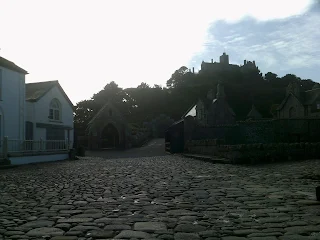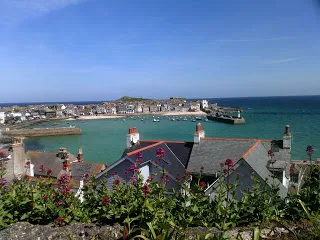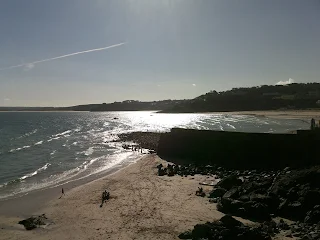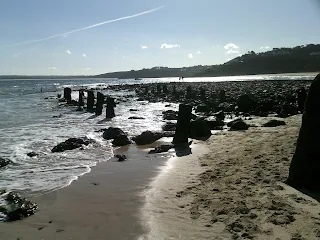Maybe I should call this a "see" rather than a "visit." Entry onto the island is only allowed with castle tickets, which I'd booked. But the powers that be decided to close the island for the day, as strong winds would have made visiting the castle unsafe.
They weren't kidding! We chose to walk the 2.7 mile coastal path to Marazion seafront, then took the causeway over to the island, making it a 3.3 mile walk in total, and the wind was certainly whipping up a wild dance! My hair ended up blowing across and sticking to my phizog, with the aid of salty, drying tears.
Here is our view from the Penzance end of the path.
St Michaels's Mount may have been the site of a monastery from the 8th to the early 11th centuries. It's been mentioned that Edward the Confessor (r.1042-1066), one of the last Anglo-Saxon kings of England, gifted the site to the Benedictine religious order of Mont Saint-Michel.
Conversely, it's also been reported that William the Conqueror (r.1066-1087) gifted the monastery of Mont Saint-Michel (its larger historic physical counterpart in Normandy, France) the Cornish island as a reward for their support in his claiming of the throne of England. St Michael's Mount then became a priory, modelled after its French equivalent. They share the same tidal characteristics and shape, although, at 57 acres, the English version is much smaller than its 247 acre brother.
I rather like the idea of this as my surname means "from La Rochelle-Normande," which (as the name suggests) is in Normandy. Here is a PDF of Mont Saint-Michel...
The castle dates to the 12th century, and a side effect of the dissolution of enemy religious houses (those under the control of a mother-house outside England) meant that from 1424 its association with Mont Saint-Michel ended.
In 1659 the mount was sold to the Colonel John St Aubyn, and in 1954 his descendent Francis Cecil St Aubyn, 3rd Baron St Levan, gave most of the mount to the National Trust, retaining a 999 year lease to inhabit the castle and manage the public viewing of its rooms.
The causeway is only accessible for a few hours each day, and even then not all year round. During the winter months the island's residents have to take the boat to the mainland. It is one of 43 tidal islands which are unbridged, and can be walked to from mainland Britain. Around 30 people now live on the island, and everyone plays their part in making sure the island runs smoothly.
This part of the causeway is actually an artery leading off to a section of rocks with built-in stairs, which act as a good viewing point. The paving stones are very rustic, and I will make an effort to buy proper walking shoes for my adventures (although my wedge sandals were grippy enough to do the job...)😀
The view from the aforementioned rocks, and the island does look rather foreboding, photographed in silhouette.
The causeway was raised one foot (30cm) higher in 1879, using sand and stones from the surrounding area. Repairs were completed in 2016, after storm damage in 2014. It's been indicated that a rise in ocean waters (along with natural erosion) could put St Michael's Mount at risk.
Peering over the barred wooden gate at the end, which was well and truly closed. I wasn't unduly upset- there was nothing I could do about the trustees' decision, and the castle and gardens and their surrounding delights will still be here the next time I come and visit.
The white building to right is the island shop.
It is thought that over 2000 years ago St Michaels Mount was a trading centre for the tin industry, with Phoenician ships exporting Cornish tin to the rest of Europe.
The harbour, and there is a short underground narrow gauge railway (a small stretch of which is apparently visible from the harbour) which is still in use to bring goods up to the island and take away rubbish. It's not open to the public.

Little is known of the village on the island before the 18th century, although apparently there were a few fishermen's and monastic cottages. It was only after harbour improvements in 1727 that St Michael's Mount began to flourish as a seaport. The population of the island was thriving in the early 1800s, with over 300 residents living down four streets, in 53 houses.
The view back down the causeway, and the cobbles are much more bobbly (and wobbly!) at this end. The SuperDean, leaning against the wall, was starting to get a bit bored and annoyed by this point. I also overheard a father lecturing his teenage son, who was similarly moaning!
An almost identical photograph to that taken earlier in the day, as we left the island and did the whole walk in reverse (no, we didn't walk backwards!😁)
The castle has featured in several films, including the 1979 film Dracula, where it represented the exterior of Castle Dracula; the James Bond film Never Say Never Again; and also in Johnny English, where it was used as the exterior for character Pascal Sauvage's chateau.
Overlooking the blustery beach, whilst trying to avoid sand in the eyes, and Land's End is somewhere behind the headland to the centre of the photo...
When I get the chance, I will return to do a full investigation of the island, castle and gardens.
* * * * *
Well, two years later I returned- only to have my castle visit cancelled due to bad weather (to be fair, the day turned out to be appalling). But this time we were allowed to wander around the island.
We took a rather wet walk around the harbour...
This witch's hut is where tickets up to the castle are checked...
The steps up to the castle do look rather rustic...
The Island Shop is within this section of buildings, as is the Visitor Centre...

Macabre little moi just had to look through to the graveyard, although the church is contained within the castle...
Since 1892 St Michael's Mount has been part of Marazion parish...
The church of St Michael & All Angels was largely rebuilt in the 14th century, although the footprint of the church dates back to 1135.
The Island Café is within these walls...
Standing by the café and looking past the graveyard walls over to the gardens...
The gardens are hidden behind the trees and are accessible on some days. Apparently you can get a clear view of them from the castle, meaning it's might not be necessary to pay the separate admission fee...
Looking back to a blurry Marazion, and the fine, spitting rain was really giving it some at this stage...
Looking across the outside dining area and over the causeway...
* * * * *
2023 update- I finally made it inside the castle! But I was filming, and my work was unusable as stupid me got my exposure wrong (ooh err missus!)😁
But here are a few phone photos.
Looking over the harbour as we arrived. This time we had to take the boat both ways as the causeway was inaccessible.
The view from over the castle walls. Peer, and you can make out the drowned causeway...
Legend had it that here lies the stone heart of Cormoran; Cornwall's most feared giant. He was lured into a hole, and all that remained was his petrified heart.
You can see it clearly here, standing just beyond the sign and turning back- it's not to be confused with the larger, similarly-shaped stone you can see in the previous photo!
* * * * *
I loved this St Michael's Mount model, located inside the Visitor Centre...
By the time we crossed the causeway the rain had turned heavy, so we took the bus back into Penzance. Here's a lone seagull looking at us like we were daft...
I'm sure one day I'll come back and the castle will be open and I'll get some decent photos (*sighs!*)
Until then...
TTFN
The Miss Elaineous
XXXXX
XXX
X














































































